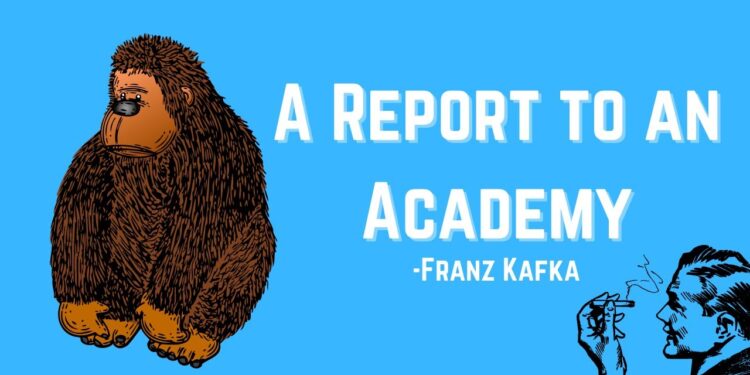Introduction
A Report To An Academy Summary By Franz Kafka “A Report to an Academy,” written in 1917 and published in 1919, is a thought-provoking narrative that explores themes of identity, transformation, and the complexities of communication. Presented as a fictional report delivered by an ape named Red Peter to a gathering of the Academy, the story delves into Kafka’s reflections on society, the nature of humanity, and the absurdities of modern life.A Report To An Academy Summary By Franz Kafka
A Report To An Academy Summary By Franz Kafka Through Red Peter’s unique perspective, Kafka critiques the expectations imposed by civilization and examines the compromises one must make to fit into societal norms. This summary will provide an in-depth analysis of the story, highlighting key themes, character development, and literary techniques employed by Kafka.A Report To An Academy Summary By Franz Kafka
Summary of the Story
Setting and Context
The story is set in a vague, unspecified location and time, aligning with Kafka’s typical use of ambiguous settings. The Academy represents an institution of knowledge and culture, which contrasts with Red Peter’s origins as a wild ape. This juxtaposition underscores the story’s exploration of civilization versus savagery and the transformative process required to assimilate into human society.
READ MORE
The Character of Red Peter
Red Peter is a unique character, an ape who has undergone a dramatic transformation to become more human-like. As he delivers his report, the reader learns about his life before captivity and his subsequent adaptation to human society. Red Peter’s character serves as a vehicle for Kafka to critique the societal expectations and norms that govern behavior and identity.A Report To An Academy Summary By Franz Kafka
The Report
A Report To An Academy Summary By Franz KafkaThe narrative unfolds as Red Peter recounts his journey from the wild to civilization. He describes his capture by humans, a traumatic event that forces him into a life of confinement. Initially, he struggles to adapt to his new environment, expressing feelings of anger and confusion. This transformation reflects Kafka’s broader themes of alienation and the loss of individuality in the face of societal pressures.A Report To An Academy Summary By Franz Kafka

Learning to Speak
A significant portion of Red Peter’s report focuses on his experience learning to communicate. He describes the process of acquiring language, which becomes a metaphor for his assimilation into human culture. Red Peter’s struggle to articulate his thoughts highlights the limitations of language as a means of true expression. His ability to speak is not a sign of enlightenment but rather a tool for survival, illustrating the compromises required to fit into society.A Report To An Academy Summary By Franz Kafka
The Role of the Academy
As Red Peter addresses the Academy, he highlights the absurdity of the institution and its members. The Academy, which represents the pinnacle of human achievement, becomes a backdrop for Red Peter’s performance. His report, delivered with wit and eloquence, serves to entertain the audience while simultaneously critiquing their understanding of civilization. Kafka uses this setting to explore the contradictions inherent in societal structures and the expectations placed on individuals.
The Transformation of Identity
Throughout the story, Red Peter grapples with his dual identity as both an ape and a human. His transformation raises questions about the nature of identity and the extent to which individuals must conform to societal norms. Red Peter’s journey reflects Kafka’s exploration of the alienation experienced by individuals in modern society. Despite his efforts to assimilate, Red Peter remains an outsider, trapped between two worlds.
The Themes of Alienation and Conformity
Kafka’s exploration of alienation is central to the narrative. Red Peter’s transition from a wild animal to a speaking human encapsulates the loss of freedom and individuality that accompanies conformity. As he reflects on his experiences, it becomes clear that his transformation has come at a significant cost. The story serves as a critique of the societal pressures that force individuals to abandon their true selves in order to fit in.A Report To An Academy Summary By Franz Kafka
The Final Thoughts
In the conclusion of his report, Red Peter acknowledges the absurdity of his situation. While he has successfully adapted to human society, he remains acutely aware of the underlying tensions and contradictions. The final lines of the story encapsulate Kafka’s exploration of the absurdities of existence and the struggle for authenticity in a world governed by arbitrary rules.
READ MORE
Themes and Analysis
The Nature of Identity
A central theme in “A Report to an Academy” is the fluidity of identity. Red Peter’s transformation raises questions about the nature of selfhood and the extent to which identity is shaped by external forces. Kafka explores the idea that identity is not fixed but rather constructed through experiences and societal expectations. Red Peter’s struggle to reconcile his past as an ape with his present as a speaking human highlights the complexities of identity formation.
Alienation and Conformity
Kafka’s critique of conformity is evident throughout the narrative. Red Peter’s journey reflects the alienation experienced by individuals who are forced to conform to societal norms. His transformation from a free animal to a speaking human serves as a metaphor for the loss of individuality in the face of societal pressures. The story raises questions about the price of conformity and the sacrifices made in the pursuit of acceptance.
Language and Communication
Language plays a pivotal role in Red Peter’s transformation. His ability to speak is both a tool for survival and a source of alienation. Kafka suggests that language, while essential for communication, can also be a barrier to true understanding. Red Peter’s struggle to articulate his thoughts underscores the limitations of language in conveying authentic experiences and emotions.
READ MORE
The Absurdity of Existence
Kafka’s exploration of absurdity is woven throughout the narrative. Red Peter’s report serves as a commentary on the absurdities of modern life and the arbitrary nature of societal expectations. The juxtaposition of a speaking ape addressing an Academy highlights the absurdity of human civilization. Kafka invites readers to reflect on the contradictions inherent in societal norms and the arbitrary nature of identity.
The Role of the Academy
The Academy serves as a microcosm of society, representing the institutions that shape human culture. Red Peter’s engagement with the Academy underscores the absurdity of academic pursuits and the limitations of human knowledge. Kafka critiques the notion of expertise and the ways in which institutions can stifle individuality and creativity.A Report To An Academy Summary By Franz Kafka
Literary Techniques
First-Person Narrative
Kafka employs a first-person narrative to provide an intimate glimpse into Red Peter’s thoughts and feelings. This perspective allows readers to engage directly with Red Peter’s experiences, fostering empathy for his struggles. The use of first-person narration also highlights the isolation experienced by Red Peter as he attempts to navigate the complexities of human society.
Irony and Humor
The story is infused with irony and humor, which serve to enhance its critical tone. Red Peter’s witty observations and clever commentary on human behavior provide comic relief while simultaneously revealing the absurdities of civilization. Kafka’s use of humor underscores the contradictions within society and invites readers to question established norms.
Symbolism
Kafka employs symbolism throughout the narrative, particularly in the character of Red Peter. His transformation from an ape to a human symbolizes the compromises individuals make to conform to societal expectations. The Academy serves as a symbol of human civilization, representing the institutions that shape identity and knowledge.
Ambiguity
The story is characterized by its ambiguity, particularly regarding the setting and the nature of Red Peter’s transformation. Kafka’s use of vague descriptions invites readers to interpret the narrative in multiple ways, reflecting the complexities of identity and the human experience. This ambiguity enhances the story’s thematic depth and allows for a range of interpretations.A Report To An Academy Summary By Franz Kafka

Conclusion
“A Report to an Academy” is a compelling exploration of identity, alienation, and the absurdities of human existence. Through the character of Red Peter, Kafka critiques the expectations imposed by society and the compromises individuals make in the pursuit of acceptance. The narrative raises profound questions about the nature of selfhood and the complexities of communication, inviting readers to reflect on the intricacies of the human experience. Kafka’s masterful use of irony, humor, and symbolism enhances the story’s thematic richness, making it a significant work in the realm of modern literature.
(FAQs)
1. What is the central theme of “A Report to an Academy”?
The central theme revolves around identity, alienation, and the absurdities of conformity in society. Through Red Peter’s transformation, Kafka critiques the expectations imposed by civilization and explores the complexities of human identity.A Report To An Academy Summary By Franz Kafka
2. Who is Red Peter, and what does he represent?
Red Peter is an ape who has been captured and transformed into a speaking human. He represents the struggle between individuality and societal expectations, illustrating the compromises individuals make to fit into human culture.
3. How does language play a role in the story?
Language is a critical aspect of Red Peter’s transformation. While it serves as a tool for communication, it also highlights the limitations of expressing true identity and experiences. Red Peter’s struggle with language underscores the complexities of human interaction.
4. What is the significance of the Academy in the narrative?
The Academy represents human civilization and the institutions that shape culture and knowledge. It serves as a backdrop for Red Peter’s report, highlighting the absurdity of societal expectations and the limitations of human understanding.
5. How does Kafka use humor in the story?
Kafka employs irony and humor to critique societal norms and highlight the absurdities of modern life. Red Peter’s witty observations provide comic relief while simultaneously revealing deeper truths about human behavior.
6. What does the story suggest about conformity?
The story critiques the pressures of conformity and the alienation experienced by individuals who must adapt to societal expectations. Red Peter’s transformation symbolizes the loss of individuality that can accompany the pursuit of acceptance.
7. How does “A Report to an Academy” reflect Kafka’s writing style?
Kafka’s writing style is characterized by ambiguity, irony, and a focus on the complexities of human existence. These elements are present in “A Report to an Academy,” enhancing the thematic depth of the narrative.
8. What is the significance of Red Peter’s dual identity?
Red Peter’s dual identity as both an ape and a human reflects the complexities of selfhood and the challenges of navigating societal expectations. His struggle to reconcile these identities underscores the themes of alienation and conformity.
READ MORE

















